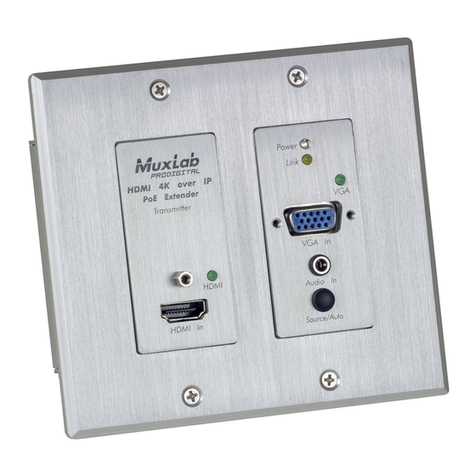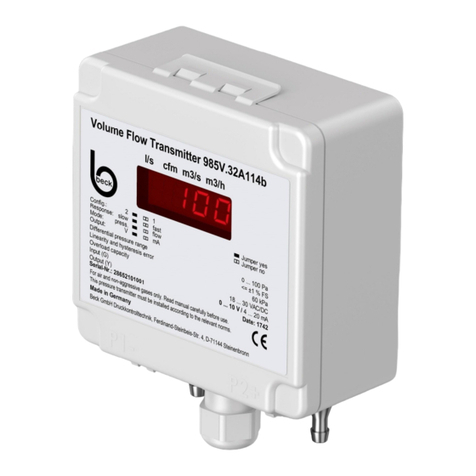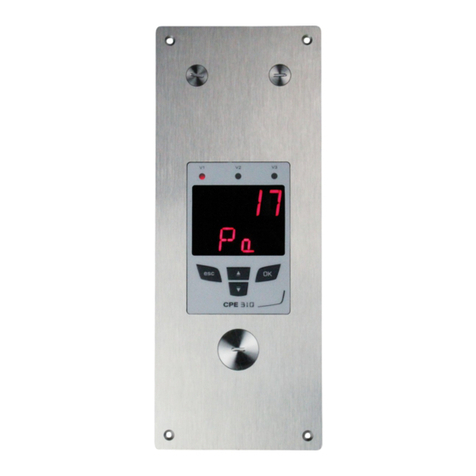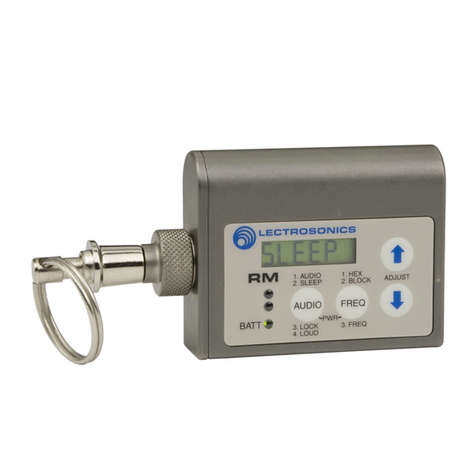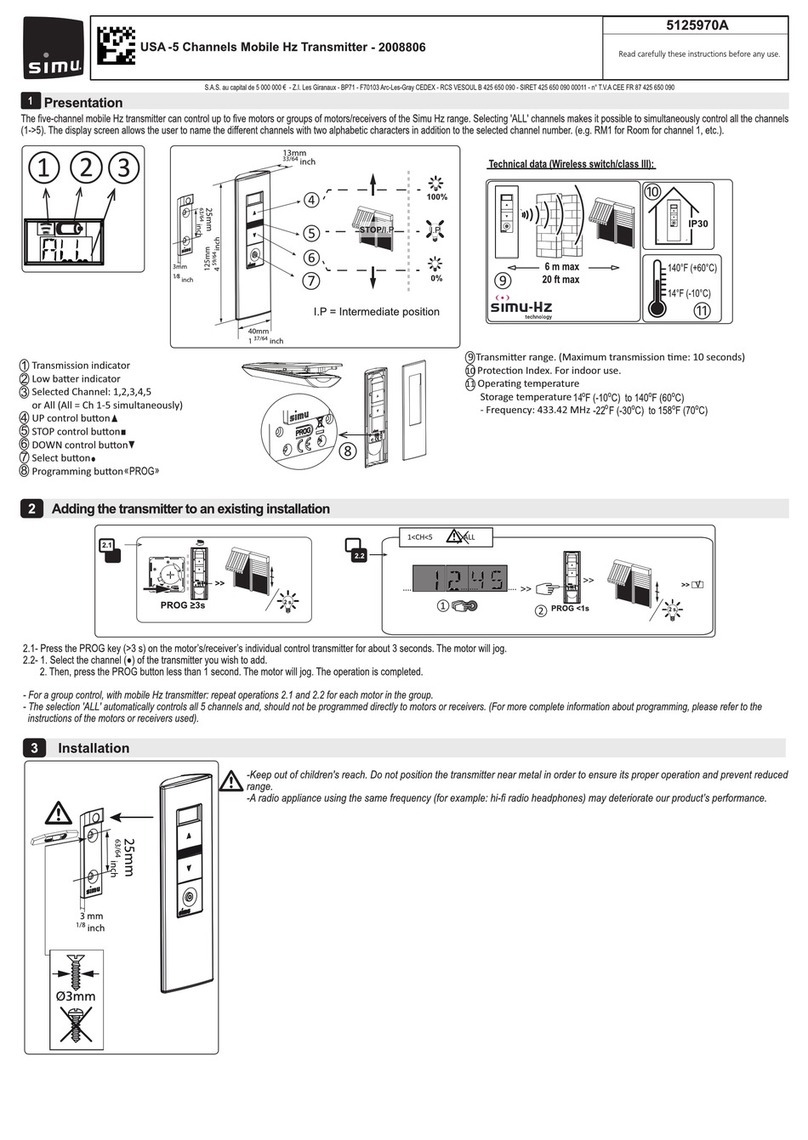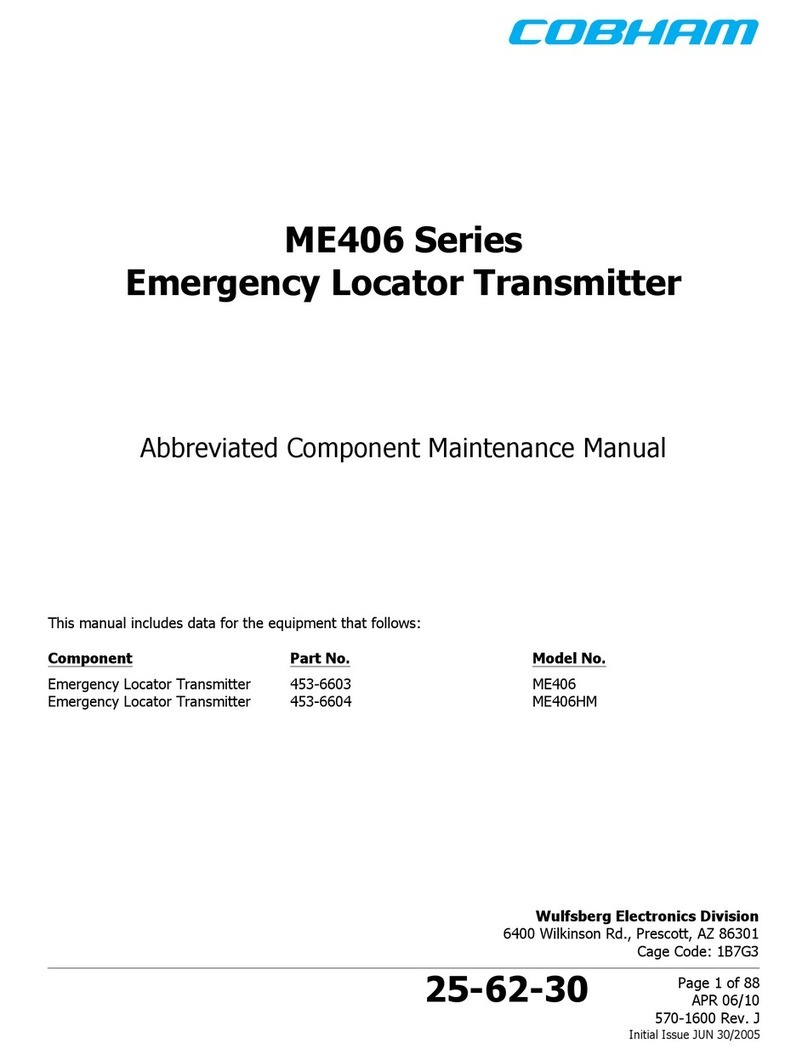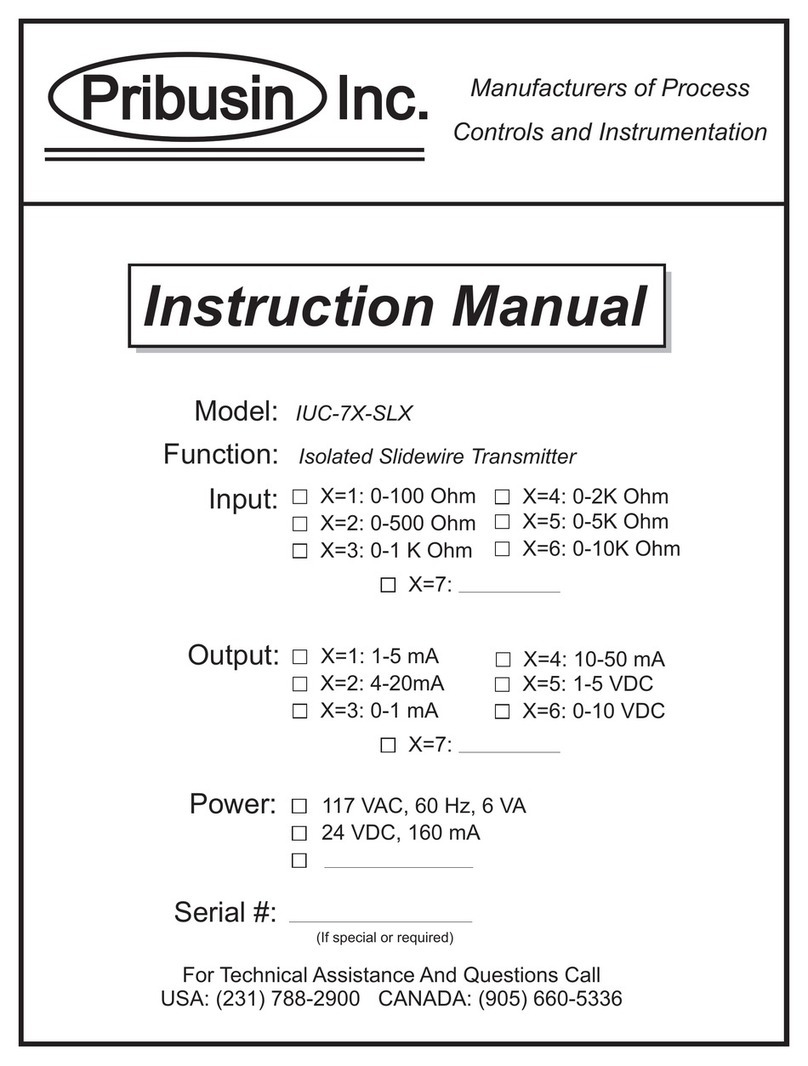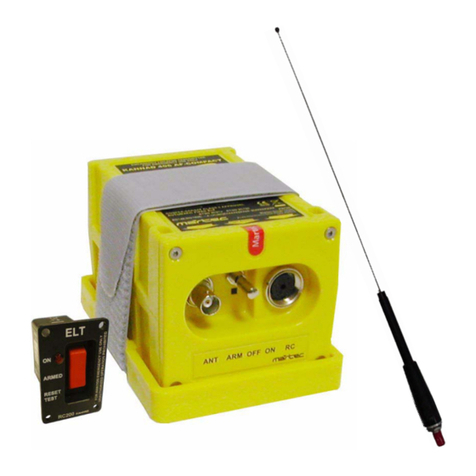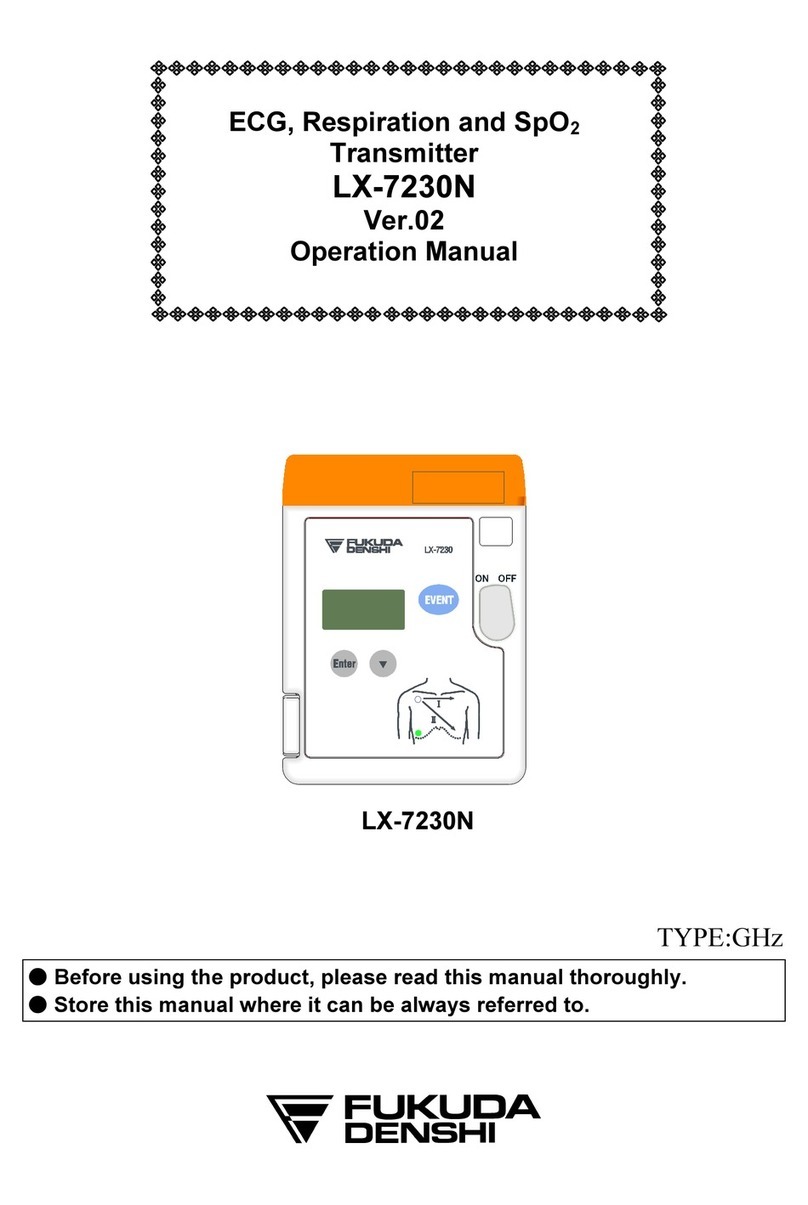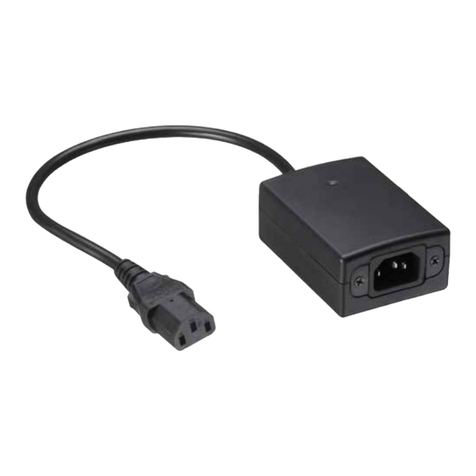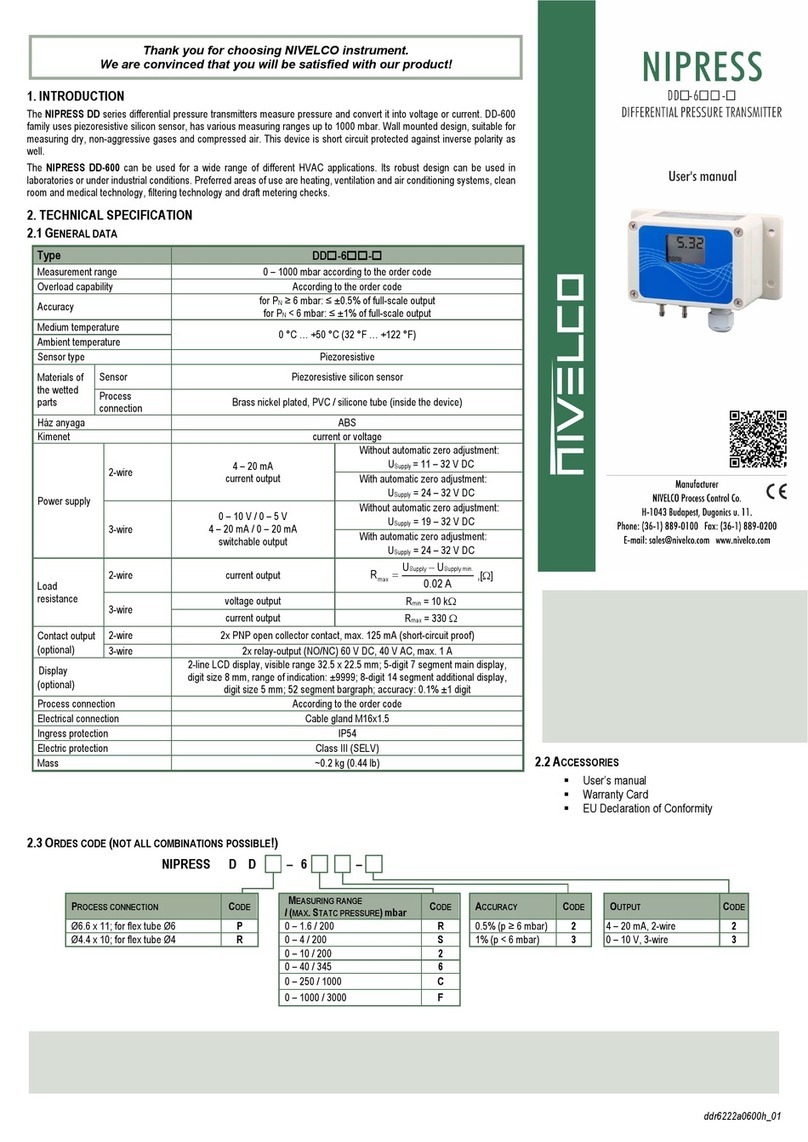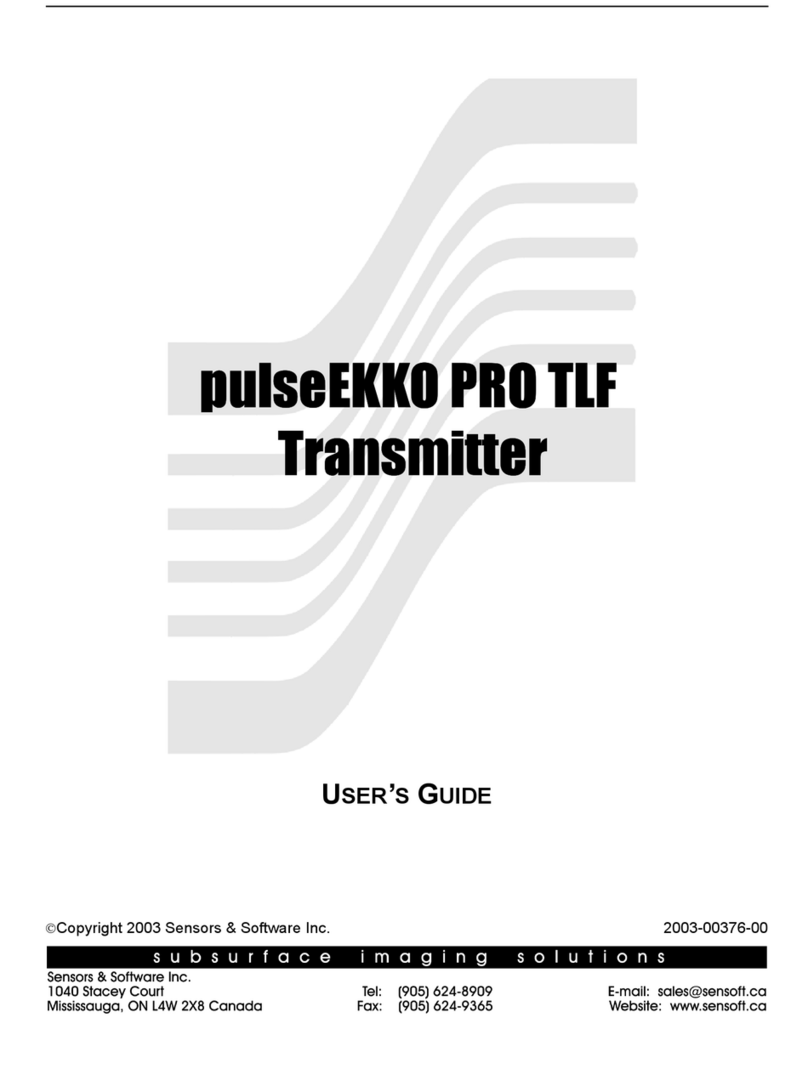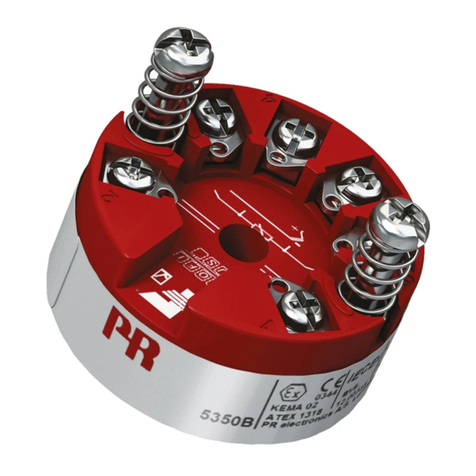Technisonic Industries Limited TiL-92-SC User manual

VHF/AM SINGLE CHANNEL
TRANSMITTERS
MODEL TiL-92-SC
25 WATT TX, P/N 931037-1 (TST-4100)
15 WATT TX, P/N 931038-1 (TST-4200)
7 WATT TX, P/N 931039-1 (TST-4300)
Installation and
Operating Instructions
Til Document No.
93RE126
Rev. C
October 2002
Technisonic Industries Limited
240 Traders Blvd., Mississauga, Ontario L4Z 1W7 Tel:(905)890-2113 Fax:(905)890-5338
web site: www.til.ca

Page A
WARNING
Do not make physical contact with antenna when transmitter is on. This unit can produce up to 30 watts of
power (depending on configuration) when transmitting.
CAUTION
This unit contains static sensitive devices. Wear a grounded wrist strap and/or conductive gloves when
handling printed circuit boards.
WARRANTY INFORMATION
The Model 92-SC series, rack mounted Single Channel Transmitters, are under warranty for one year from
date of purchase. Failed units caused by defective parts, or workmanship should be returned to:
Technisonic Industries Limited
240 Traders Blvd.
Mississauga, Amherst, NY
Ontario L4Z 1W7
Tel: (905) 890-2113 Tel: (716) 691-0669
Fax: (905) 890-5338

i
TABLE OF CONTENTS
Paragraph Title Page
SECTION 1 GENERAL DESCRIPTION
1.1 Introduction ........................................................... 1-1
1.2 Description ........................................................... 1-1
1.2.1 Transmitter Module .................................................... 1-2
1.2.2 Power Supply Modules - Models SPG-007, SPG-015, SPG-025 ................ 1-2
1.2.3 RF Amplifier Modules - Models PA-15, PA-25 ............................... 1-2
1.2.4 MotherBoard ......................................................... 1-2
1.2.5 RemoteControlBoards ................................................. 1-2
1.2.6 RFIsolator(Option2)................................................... 1-3
1.3 Modes of Operation .................................................... 1-3
1.3.1 Local/RemoteOperation ................................................ 1-3
1.3.1.1 ConferenceAudio ...................................................... 1-4
1.3.2 AC and DC Operation .................................................. 1-4
1.4 TechnicalSummary.................................................... 1-4
SECTION 2 PREPARATION FOR USE AND STORAGE
2.1 Introduction ........................................................... 2-1
2.2 Disassembly/Assembly ................................................. 2-1
2.2.1 Remove/ReplaceCoverAssembly ........................................ 2-1
2.2.2 Remove/Replace Transmitter Module ..................................... 2-1
2.2.3 Remove/Replace Memory Set Board Module A5A1 .......................... 2-3
2.2.4 Remove/ReplaceControlBoard .......................................... 2-3
2.3 Channel Frequency Selection ............................................ 2-5
2.3.1 Introduction ........................................................... 2-5
2.3.2 Frequency Range ...................................................... 2-5
2.3.3 Pre-Programming Channel Frequency .................................... 2-5
2.3.4 Offset Frequency Set .................................................. 2-5
2.4 RemoteOperationSetUp ............................................... 2-9
2.4.1 Remote Control Board P/N 923051-1 ..................................... 2-10
2.4.2 Remote Control Board P/N 940180-1 ..................................... 2-11
2.5 Transmitter Adjustments and Settings .................................... 2-14
2.6 Operational Check .................................................... 2-14
2.7 Storage ............................................................. 2-14

ii
TABLE OF CONTENTS (Continued)
Paragraph Title Page
SECTION 3 OPERATING INSTRUCTIONS
3.1 Introduction ........................................................... 3-1
3.2 Installation............................................................ 3-1
3.3 Operator's Switches, Controls and Indicators ................................ 3-1
3.4 OperatingInstructions .................................................. 3-4
3.4.1 Transmitter Operation (Local Mode) ....................................... 3-4
3.4.2 SwitchingOFF ........................................................ 3-5
3.4.3 ExternalDCOperation .................................................. 3-5
LIST OF TABLES
Table No. Title Page
1-1 92-SC Leading Particulars . . . .............................................. 1-5
2-1 Frequency Selection MHz . . . .............................................. 2-7
2-2 Frequency Selection KHz . . . .............................................. 2-8
2-3 Remote Control Connector Functions ....................................... 2-9
2-4 Remote Control Board P/N 923051-1 Settings ............................... 2-10
2-5 Remote Control Board P/N 943180-1Settings ................................ 2-11
3-1 Operator's Switches, Controls and Indicators .................................. 3-3
LIST OF ILLUSTRATIONS
Figure No. Title Page
1-1 VHF/AM Single Channel Transmitter ........................................ 1-1
2-1 Single Channel Transmitter - Internal View ................................... 2-2
2-2 Single Channel Memory Set Board - Module A5A1 ............................. 2-4
2-3 Remote Control Board P/N 923051-1 ....................................... 2-13
2-4 Remote Control Board P/N 943180-1 ....................................... 2-14
2-5 Transmitter Adjustments and Settings . . . . . . . . . . . . . . . . . . . . . . . . . . . . . . . . . . . . . . 2-15
3-1 Single Channel Transmitter Controls and Indicators . . . ......................... 3-2

1-1
SECTION 1
GENERAL DESCRIPTION
1.1 INTRODUCTION
This publication provides general information on the VHF/AM Single Channel Transmitters,
Model TiL-92-SC, Part Nos. 931037-1, 931038-1, and 931039-1 manufactured by Technisonic
Industries Limited. These units are also referred to by Item No.'s TST-4100, TST-4200 and
TST-4300 respectively.
The Model TiL-92-SC Transmitters are single channel, fixed frequency transmitters operating
over the frequency range of 117.975 MHz to 138.000 MHz. These units are intended for base
station operation in an air traffic environment. These systems can operate from AC power or
external DC power in local and remote operating modes.
1.2 DESCRIPTION
The three rack mounted transmitter configurations are based on the Model 90-6R pre-
programmable transceiver module, modified for transmit only operation. All systems can be optionally
configured for 2 Wire mode with Current, or Tone remote control operation. Each configuration
consists of a Power Supply Module, Mother Board, and Control Board. The 15 Watt and 25 Watt
configurations also consist of an RF Linear Amplifier Module.
The TST series transmitters now come standard with an RF Isolator which provides
unidirectional coupling to the antenna in multiple transmitter configurations.
Figure 1-1 VHF/AM Single Channel Transmitter

1-2
1.2.1 Transmitter Module
The Single Channel Transmitter is based on Transceiver Model 90-6R, modified for transmit only
operation. The transmitter module is a low power VHF/AM transmitter which can transmit on a single
pre-programmable synthesized frequency, with 25kHz channel spacing in the frequency range
117.975 MHz to 138.000 MHz. The single channel memory set board, module A5A1 is mounted
external to the transmitter module to facilitate ease of frequency programming.
1.2.2 Power Supply Modules - Models SPG-007, SPG-015, SPG-025
The Power Supply Modules provide the DC supply voltage to the transmitter and linear amplifier, and
houses a battery charger which can provide charging and trickle charging to external rechargeable
batteries. Model SPG-007 is for use in the 7 Watt configurations, Model SPG-015 is for use in the 15
Watt configurations, Model SPG-025 is for use in the 25 Watt configurations.
1.2.3 RF Amplifier Modules - Models PA-15, PA-25
The RF Amplifier modules provide 15 Watt (Model PA-15) or 25 Watt (Model PA-25) power
output. The RF Amplifiers are fed by the 7 Watt RF output from the transmitter module.
1.2.4 Mother Board
The Mother Board provides all interconnection between the two external remote control connectors,
RF Amplifier Module, Power Supply, Remote Control Board, and Transmitter. The Remote Control
Board, RF Isolator and all internal fuses are mounted on the Mother Board.
1.2.5 Remote Control Boards
1. Line Interface Board P/N 923051-1
Provides remote control transceiver operation on 2 wire or 4 wire 600 ohm lines. This board can be
configured to key the transmitter using a 2175 Hz* continuous tone (see below), plus/minus DC
Voltages, ground keying and internal or external DC (15 mA) current loop keying. Transmit audio is
user selectable for two wires or four wires. *Crystals for tone frequencies other than 2175 Hz may be
obtained by special order (ie/2380 Hz).
2. Line Interface Board P/N 943180-1
Provides remote control transmitter operation on 2 wire dedicated 600 ohm lines utilizing the EIA
multi-tone keying format found in the Land Mobile Industry. A high level 2175 tone followed by a 1950
Hz guard tone and then a low level 2175 Hz continuous tone is utilized to key the transceiver. The
943180-1 board can also be jumper strapped for standard aeronautical 2175 Hz continuous tone
operation. DC (15mA) current loop and ground keying is also supported. However this board does
not support 4 wire operation.
NOTE P/N 923051-1 is the default board supplied in all units. The EIA multi-tone board
P/N 943180-1 must be special ordered. To determine which remote card your 92-SC has installed the
Configuration label on the side of the rack mount chassis should be consulted.

1-2
1.2.6 RF Isolator (Now standard on all units)
The RF Isolator is a broadband (118 MHz - 138 MHz) RF directional coupler. The RF Isolator provides
20 dB of isolation between the antenna and RF Amplifier while providing 0.7 dB (Max.) insertion loss.
1.3 MODES OF OPERATION
1.3.1 Local/Remote Operation
The Single Channel Transmitter can be operated in Local or Remote modes.
NOTE
Local operation is not disabled when operating in
Remote mode and Remote operation is not disabled
when operating in Local mode. The two operating
modes operate in parallel.
1. LOCAL OPERATION - In local operation, voice audio, and keying (PTT) functions are
routed from the microphone (not supplied) to the transmitter.
2. REMOTE OPERATION - In Remote operation, transmit audio and keying (PTT) functions
are routed over land lines to the 600 ohm remote inputs. Internal jumpers can be set
for ±DC, ground, or tone transmitter keying, and to provide a RF Output Power signal
depending on the remote control board installed. Transmit audio is also routed to the
internal loudspeaker at an externally (high/low switch) adjustable preset level (see
conference audio).
1.3.1.1 Conference Audio
Conference Audio provides the operator with Tx voice on the transmitter speaker when the transmitter
is remotely keyed from another location. A 3-position high-off-low switch is provided to externally
control Tx audio levels. The Low position results in a 20dB lower audio level than when the switch is
in the High position.
The audio level of the transmit audio is internally adjustable from 0.0W to 0.5W of audio output. The
adjustment is performed via rotation of the potentiometer R7 (see Figure 2-6 for location), which is
accessible from the top of the transceiver after removing the top dust cover of the unit.

1-4
NOTE: The transmit audio level can be increased by rotating potentiometer R7clockwise and
decreased by counterclockwise rotation. If further adjustment of conference audio is required, the top
cover of the transmitter module must be removed to gain access to potentiometer R63, located on the
Audio Interface Module, A3 (see Figure 2-6 for location).
1.3.2 AC and DC Operation
The units can be operated by external 120/220 VAC or external 28 VDC (13.7 VDC for 7W
configurations).
1. AC OPERATION - During AC operation, the unit can charge and trickle charge external
batteries via the external connectors mounted on the rear panel of the unit. Refer to
Table 1-2 for details.
2. DC OPERATION - The unit can be operated from an external DC supply within the range
of 21.6 Vdc to 30 Vdc for 15 watt and 25 watt configurations and within the range
of 11.5 Vdc to 15.0 Vdc for 7 watt configurations.
1.4 TECHNICAL SUMMARY
A summary of electrical, operational, mechanical and physical characteristics of the Single
Channel Transmitters are provided in Table 1-1.

1-5
TABLE 1-1 LEADING PARTICULARS - TST-4100/4200/4300
POWER REQUIREMENTS:
7 Watt Transmitter
AC Input Voltage/Current ........................... 100 to 132 VAC @ 1.0 Amp
DC Input Voltage/Current ...................... 11.5VDCto15VDC@3.5Amp
15 Watt Transmitter
AC Input Voltage/Current ........................... 100 to 132 VAC @ 1.5 Amp
DC Input Voltage/Current ...................... 21.6VDCto30VDC@4.0Amp
25 Watt Transmitter
AC Input Voltage/Current ........................... 100 to 132 VAC @ 2.0 Amp
DC Input Voltage/Current ...................... 21.6VDCto30VDC@7.5Amp
NOTE: 220V operation is selectable by internal power supply jumper. Tolerances are 190 to 250 VAC
@ one-half the applicable current consumption in the 110 VAC mode.
POWER OUTPUT:
7WattTransmitter ..................................................... 5-10Watts
15WattTransmitter ................................................... 10-20Watts
25WattTransmitter ................................................... 20-30Watts
Microphone Compression Range .....................................................35dB
Battery Charger Voltage & Current.................................... 27.5Vdc,3.5AmpsMAX
REMOTE CONTROL:
Remote Audio Input ............................................. 2wire,balanced600 Ωlines
Remote Tx Timeout ..................................................... 30to300 seconds
Tone Keying:
Impedance ............................................. 600 Ωfloating with respect to ground
TxControlTone..............................................Selectable1800 Hz to 3000 Hz
Tx Tone Input Level .......................................................... 0to-40dBm
Tx Tone Control Response Time ............................................<12milliseconds
DCKeying .....................................................................±48Vdc
Loop Resistance ............................................................. 10KΩMAX
Ground Keying ......................................................... ClosuretoGround
Loop Resistance .............................................................. 4KΩMAX
TX Interface Signals:
TX RF Output Signal .................................... RFON=Ground,RF OFF=Open Circuit
Temperature & Humidity:
Operating Temperature Range .......................... -25EC(-13EF) to +55EC(+131EF)
Storage Temperature Range ........................... -55EC(-67EF) to +65EC(+149EF)
RelativeHumidity ...........................................................100%
Dimensions & Weight:
Width ...................................................... 483 mm (19.0 in) MAX
Height ........................................................ 89mm(3.5in)MAX
Depth ...................................................... 432 mm (17.0 in) MAX
Weight ....................................................... 6.3Kg(14lbs)MAX

1-6
TABLE 1-1 LEADING PARTICULARS - TST-4100/4200/4300 (Continued)
TRANSMITTER MODULE:
Dimensions & Weight:
Width ....................................................... 216 mm (8.5 in) MAX
Height ....................................................... 70mm(2.75in)MAX
Depth ..................................................... 260 mm (10.25 in) MAX
Weight .................................................... 1.8Kg(3lb15oz)MAX
TECHNICAL:
Power Output (TX module w/o PA) ........................................ 5-10Watts
Audio Input .................................................. 0.05Vrmsto2.0Vrms
Speech Processor Dynamic Range ............................................35dB
Modulation ............................................................ 95%MAX
AudioDistortion@90%mod(LowPower) .................................. 10%MAX
Audio Distortion @ 90% mod (with Linear Amplifier at High Power) ............... 15%MAX
Audio Frequency Response .............................. 300 Hz to 2,500 Hz, +1 -3 dB
SpuriousEmissions ............................................. 60dBbelowcarrier
Hum and Noise ....................................... 45dBbelowmodulated carrier

2-1
SECTION 2
PREPARATION FOR USE AND STORAGE
2.1 INTRODUCTION
This section provides the information required for custom configuration and storage of the
Single Channel Transmitter. Custom system configuration includes customizing remote control
board functions and transmit frequency selection.
2.2 DISASSEMBLY/ASSEMBLY (Refer to Figure 2-1)
2.2.1 Remove/Replace Top Dust Cover Assembly
REMOVAL
(1) Remove and retain twelve screws securing top dust cover to the 19" rack chassis.
(2) Please note the location of the three longer screws which travel through the heatsink
shims riveted to the inside of the top cover.
(3) Lift cover clear of chassis to expose internal view of transmitter as shown in Figure 2-1.
REPLACEMENT
(1) Position top cover on chassis.
(2) Position one screw in each corner of the top cover mounting holes. Place the three
longer screws into their correct holes located over the internal transmitter module.
(3) Secure cover to chassis with remaining screws.
2.2.2 Remove/Replace Transmitter Module
REMOVAL
(1) Remove dust cover as described in paragraph 2.2.1.
(2) Disconnect RF and DC connectors from rear of transmitter module.
(3) Remove and retain the screws securing the top cover of the internal transmitter module.
(4) Remove and retain two screws and two washers securing flat cable to the side of the
transmitter module and disconnect the flat cable. Disconnect the flat cable running out
of the transmitter module at the connector on the external memory set board.
(5) Remove and Retain four countersunk screws securing transmitter module to front
panel.

2-2
Figure 2-1 Single Channel Transmitter - Internal View

2-3
(6) Move the transmitter module slightly back from the front panel and disconnect the flat
cable connecting the front panel assembly to the transmitter module, audio interface
board A3. The connector is located on the A3 board.
(7) Lift transmitter module clear of chassis.
REPLACEMENT
(1) Position the transmitter module into the chassis. While holding the transmitter module
slightly back from the front panel, re-connect the flat cable from the front panel to the
A3 board in the transmitter module.
(2) Position and secure transmitter module to front panel with four countersunk screws.
(3) Connect flat cable to transmitter module. Secure flat cable to transmitter module with
two screws and two washers. Connect flat cable running out of the transmitter module
to the external memory set board.
(4) Connect DC and RF connectors to rear of transmitter module.
(5) Replace and secure the top cover of the transmitter module with the screws removed
in step (3) of the REMOVAL instructions.
(6) Replace top dust cover as described in paragraph 2.2.1.
2.2.3 Remove Replace External Single Channel Memory Set Module A5A1
REMOVAL
(1) Remove dust cover as described in paragraph 2.2.1.
(2) Remove and retain four screws securing Memory Set Board, Module A5A1 "piggy back"
to the standoffs on the power supply cover. (See Figure 2-1 for location)
REPLACEMENT
(1) Secure the Memory Set Module to the stand-offs located on the power supply cover
by the four screws.
2.2.4 Remove/Replace Control Board
REMOVAL
(1) Remove dust cover as described in paragraph 2.2.1.
CAUTION Care must be taken when removing or replacing Control Board to avoid
damage to Motherboard Connector Pins.
(2) Remove and retain four screws securing Control Board "piggy back" to the Mother
Board standoffs. Remove Control Board from Mother Board.

2-4
Figure 2-2 Single Channel Memory Set Module A5A1 - Component Layout

2-5
REPLACEMENT
(1) Align the two female connectors on the control board with the male connectors
on the Mother Board using the four mounting holes and standoffs as a guide. Secure control
board to the Mother Board standoffs with four screws and washers.
(2) Replace dust cover as described in paragraph 2.2.1.
2.3 CHANNEL FREQUENCY SELECTION
2.3.1 Introduction
Before programming a new operating frequency, perform an operational check, as outlined in
Section 3. If there is any operational deficiency or equipment malfunction, return transmitter
to the manufacturer. Before use it is necessary to pre-program the operating frequency.
2.3.2 Frequency Range
The operating frequency may be programmed over the frequency range 117.975 MHz to 138.000
MHz with 25kHz channel spacing.
2.3.3 Pre-programming Channel Frequency
Determine the operating frequency to be programmed and proceed as follows:
FREQUENCY SELECTION MHz.
Refer to Table 2-1 Frequency Selection MHz. Using the OPERATING FREQUENCY (MHz)
column, find the desired frequency in MHz. Cross-refer to the JUMPER LOCATION column, and
install the jumper as required.
FREQUENCY SELECTION KHz
Refer to Table 2-2, Frequency Selection kHz. Using the OPERATING FREQUENCY kHz column,
find the portion of the desired frequency in kHz. Cross-refer to the JUMPER LOCATION column,
and install the jumpers in the locations as required.
2.3.4 Offset Frequency Set
(A) Jumper J15, located on the single channel memory set board, module A5A1 selects
the frequency offset as follows:
(1) If J15 is not installed, frequency offset is inhibited.
(2) If J15 is installed in the Rx position, the transmit frequency will be offset high.
(3) If J15 is installed in the Tx position, the transmit frequency will be offset low.
(B) Trim capacitors C16 and C37, accessible from the bottom of the unit (see Figure 2-5),
are used to accurately adjust the transmit frequency. For the Tx frequency to be higher
than the receive frequency, proceed as follows:

2-6
TABLE 2-1 FREQUENCY SELECTION MHz
OPERATING
FREQUENCY
(MHz)
JUMPER LOCATION
20 Mhz 10 MHz 8 MHz 4 MHz 2 MHz 1 MHz
117
118
119
120
121
122
123
124
125
126
127
128
129
130
131
132
133
134
135
136
137
138
0
0
0
1
1
1
1
1
1
1
1
1
1
1
1
1
1
1
1
1
1
1
1
1
1
0
0
0
0
0
0
0
0
0
0
1
1
1
1
1
1
1
1
1
0
1
1
0
0
0
0
0
0
0
0
1
1
0
0
0
0
0
0
0
0
0
1
0
0
0
0
0
0
1
1
1
1
0
0
0
0
0
0
1
1
1
1
0
1
0
0
0
0
1
1
0
0
1
1
0
0
0
0
1
1
0
0
1
1
0
1
0
1
0
1
0
1
0
1
0
1
0
1
0
1
0
1
0
1
0
1
0
LEGEND: 0 = JUMPER BETWEEN CENTRE AND 0 1 = JUMPER BETWEEN CENTRE AND 1

2-7
TABLE 2-2 FREQUENCY SELECTION KHz
OPERATING
FREQUENCY
(KHz)
DIODE LOCATION
800 KHz 400 KHz 200 KHz 100 KHz 50 KHz 25 KHz
000
025
050
075
100
125
150
175
200
225
250
275
300
325
350
375
400
425
450
475
500
525
550
575
600
625
650
675
700
725
750
775
800
825
850
875
900
925
950
975
0
0
0
0
0
0
0
0
0
0
0
0
0
0
0
0
0
0
0
0
0
0
0
0
0
0
0
0
0
0
0
0
1
1
1
1
1
1
1
1
0
0
0
0
0
0
0
0
0
0
0
0
0
0
0
0
1
1
1
1
1
1
1
1
1
1
1
1
1
1
1
1
0
0
0
0
0
0
0
0
0
0
0
0
0
0
0
0
1
1
1
1
1
1
1
1
0
0
0
0
0
0
0
0
1
1
1
1
1
1
1
1
0
0
0
0
0
0
0
0
0
0
0
0
1
1
1
1
0
0
0
0
1
1
1
1
0
0
0
0
1
1
1
1
0
0
0
0
1
1
1
1
0
0
0
0
1
1
1
1
0
0
1
1
0
0
1
1
0
0
1
1
0
0
1
1
0
0
1
1
0
0
1
1
0
0
1
1
0
0
1
1
0
0
1
1
0
0
1
1
0
1
0
1
0
1
0
1
0
1
0
1
0
1
0
1
0
1
0
1
0
1
0
1
0
1
0
1
0
1
0
1
0
1
0
1
0
1
0
1
LEGEND: 0 = JUMPER BETWEEN CENTRE AND 0 1 = JUMPER BETWEEN CENTRE AND 1

2-8
2.3.4 Offset Frequency Set (continued)
(1) Set jumper J27 on the memory set board to Rx position.
(2) Key PTT and set the transmitted frequency (without modulation) by rotating
C16* to the desired Tx frequency. *(Revised from C37 in Rev.B document).
(3) Set jumper J27 to Tx position. Key PTT and without modulation set the transmitted
frequency by rotating trim capacitor, C37 to the desired Rx frequency.
(4) Set jumper J27 to the Rx position, key the PTT and without modulation, verify
that the transmitted frequency is the desired Tx frequency. If not, repeat steps
2, 3 and 4.
For the Tx frequency to be lower than the the Rx frequency proceed as follows:
(1) Set jumper J27 to the Rx position. Key the PTT and without modulation set
the transmitted frequency, rotating trim capacitor C16 to the desired Rx frequency.
Release PTT.
(2) Set Jumper J27 to the Tx position. Key the PTT and without modulation set
the transmitted frequency by rotating trim capacitor C37 to the desired transmit
frequency. Release PTT.
(3) Set jumper J27 to thr Rx position. Key the PTT and without modulation, verify
that the transmitted frequency is the desired receive frequency. If not repeat steps
1, 2, and 3. If it is, release the PTT and set jumper J15 to the Tx position, thus
completing the frequency tuning.

2-9
2.4 REMOTE OPERATION SETUP
The Procedures listed below enable the user to custom configure the unit for external remote
control hardware. Refer to Table 2-3 for connector pin details on Remote Control D Connector
located at rear of Single Channel Transmitter. Position Jumpers on Control board as indicated
in Table 2-4 or Table 2-5 as required. Refer to Figure 2-3 and Figure 2-4 for board locations.
Verify Remote Control operation in accordance with manufacturers instructions.
DC KEYING - In ± DC keying, a positive voltage between +10 Vdc and +48 Vdc or negative voltage
between -10 Vdc and -48 Vdc will key the transmitter. A DC voltage between -5 Vdc and +5 Vdc will
not key the transmitter.
TONE KEYING - In Tone keying a tone of 2175 Hz or 2380 Hz (Optional) can be used to key
the transmitter. Tone sensitivity is adjustable from -40 dBm to 0 dBm.
GROUND KEYING - In Ground Keying the transmitter is keyed by shorting the control point
(landline or External Keying) to chassis ground
CURRENT LOOP KEYING - In Current Loop keying, an internal or external current source (15
mA) is used to key the transmitter
EIA TONE KEYING - The EIA multi-tone keying format is found in the Land Mobile Industry. A high
level 2175 Hz tone followed by a 1950 Hz guard tone then a low level 2175 Hz continuous tone is
utilized to key the transceiver.
TABLE 2-3 REMOTE CONTROL CONNECTOR FUNCTIONS
9 PIN
NO
25 PIN
NO
Connector Pin Functions
A,B
C,D
H
N/A
K
J
N/A
E(-),F(+)
N/A
N/A
9,21
10,22
12,24
8
13
1,2,14,15
25
23(-),11(+)
20
3,4,5,6,7,16,17,
18, 19
2 Wire Tx Audio Line (600 Ω)
Not Connected
External DC In (+24 Vdc), For 7W Transmitter (+12 Vdc)
Not Connected
Single Line Keying (PTT)
Ground
Not Connected
Carrier Control
RF Indicator
Not Connected, allocated for future functions

2-10
2.4.1 Two Wire Remote Control Board P/N 923051-1
Provides remote control transmitter operation on 2 wire 600 ohm lines. This board can be configured
to key the transmitter using a 2175 Hz tone (2380 Hz upon request), plus/minus DC Voltages, ground
keying and internal or external current loop keying. Transmit is provided over two wires. Crystals for
tone frequencies other than 2175 Hz or 2380 Hz may be obtained by special order.
See Figure 2-3 for location of jumpers referred to in the following table. Pins are numbers
increase as you go from top to bottom or left to right on the connector.
TABLE 2-4 REMOTE CONTROL BOARD P/N 923051-1 SETTINGS
CONTROL FUNCTION
J1 Jumper Pin 1 and Pin 2 for DC Current Loop Keying
Jumper Pin 2 and Pin 3 for ± DC Keying or Ground Keying.
Note: SW2 must be in position 2 if Pin 2 and Pin 3 are jumpered.
J2
J3
J7
J6
SW1
SW2
Y1,Y2
R7
R22
R25
R44
R10
Jumper Pin 1 and Pin 2 for Ground Keying (Land Line).
Jumper Pin 1 and Pin 4 for ± DC Keying (Land Line).
Jumper Pin 2 and Pin 3 for Ground Keying (Single Key Line).
Jumper Pin 3 and Pin 6 for ± DC Keying (Single Key Line).
Jumper Pin 2 and Pin 5 for No Function.
Jumper Pin 1 and Pin 2 for ± DC or Ground Keying.
Jumper Pin 4 and Pin 5 for Tone Keying.
Note: Both Options may be selected.
Jumper Pin 2 and Pin 3 for No Function.
Jumper Pin 5 and Pin 6 for No Function.
Jumper Pin 1 and Pin 2 to enable Timeout Timer.
Jumper Pin 2 and Pin 3 to disable Timeout Timer.
Jumper Pin 1 and Pin 2 to for Internal Current Loop Keying.
Jumper Pin 2 and Pin 3 to for External Current Loop Keying.
Position 1 Selects 2 Wire Operation. (Switch has no effect in Transmitter).
Position 2 Selects 4 Wire Operation.
Position 1 Selects Normal (Land Line Keying).
Position 2 Selects Local (Single Line Keying).
Determines Keying Tone Frequency.
Sets Tx Audio IN Level (Range -18 dBm to +10 dBm).
Sets Key Tone Level (Range -40 dBm to 0 dBm).
Sets Rx Audio OUT Level (Range -15 dBm to +10 dBm).
Sets Timeout Timer (Range 30 to 300 Seconds).
Sets Receive Audio Output Balance.
Other manuals for TiL-92-SC
1
Table of contents
